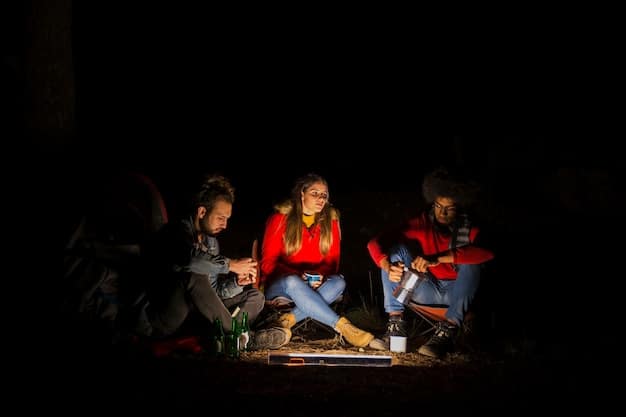Authentic Travel Stories: Why They Matter in Today’s World

The growing demand for authentic travel stories reflects a shift from aspirational tourism to seeking genuine experiences and deeper connections with destinations and cultures, driven by a desire for meaningful and trustworthy content.
In today’s digital age, the travel landscape is constantly evolving. Among the emerging trends, the growing demand for authentic travel stories stands out as a significant shift in how people experience and connect with the world.
The Rise of Authenticity in Travel Narratives
Travel has always been about more than just seeing new places. It’s about experiencing different cultures, connecting with people, and creating lasting memories. Today, travelers are increasingly seeking authenticity in the stories they consume, moving away from highly curated, picture-perfect portrayals of destinations.
This pursuit of genuine experiences is fueled by a desire for deeper understanding and connection with the world. Readers are looking for travel narratives that resonate with their values and offer valuable insights, rather than simply showcasing idealized versions of reality.
Why Authentic Stories Resonate
Authentic travel stories resonate with readers for several key reasons. They build trust, offer unique perspectives, and inspire a sense of connection.
- Building Trust: Readers are more likely to trust stories that feel genuine and honest, rather than overly promotional or sanitized.
- Offering Perspective: Authentic stories often provide insights into local cultures, challenges, and triumphs, enriching the reader’s understanding of the world.
- Inspiring Connection: By sharing personal experiences, writers can create a sense of connection with their audience, fostering a community of like-minded travelers.
Ultimately, the rise of authenticity in travel narratives reflects a desire for more meaningful and impactful travel experiences. Readers are seeking stories that challenge their perspectives, inspire their imaginations, and connect them with the world on a deeper level.

The Role of Storytelling in Shaping Travel Perceptions
Storytelling plays a crucial role in shaping how we perceive the world, and travel stories are no exception. The narratives we consume influence our expectations, desires, and ultimately, our travel decisions. With the growing demand for authentic storytelling, the industry has the opportunity to redefine travel perceptions for the better.
By moving away from superficial representations and embracing genuine narratives, storytellers can create a more nuanced and accurate portrayal of destinations, encouraging travelers to engage with local cultures in a respectful and meaningful way.
Creating Responsible Travel Narratives
Responsible travel narratives prioritize ethical considerations and cultural sensitivity. They encourage travelers to be mindful of their impact and to engage with local communities in a way that benefits both visitors and residents.
This includes promoting sustainable practices, supporting local businesses, and amplifying the voices of marginalized communities. By doing so, storytellers can contribute to a more equitable and responsible travel industry.
- Promoting Sustainability: Highlighting eco-friendly accommodations and practices can inspire travelers to make more sustainable choices.
- Supporting Local Businesses: Featuring locally owned restaurants, shops, and tour operators can boost the local economy and promote cultural preservation.
- Amplifying Local Voices: Sharing stories from local perspectives can provide valuable insights and challenge stereotypes.
In conclusion, storytelling has the power to shape travel perceptions and promote responsible tourism. By embracing authenticity and ethical considerations, storytellers can inspire travelers to connect with the world in a more meaningful and sustainable way.
Connecting with Readers Through Emotion and Vulnerability
One of the most effective ways to connect with readers on a deeper level is by sharing emotions and vulnerabilities. Authentic travel stories often delve into personal challenges, moments of self-discovery, and unexpected encounters that shape the traveler’s experience.
By being open and honest about their own struggles and triumphs, writers can create a sense of empathy and connection with their audience. This vulnerability invites readers to reflect on their own experiences and to see travel as a journey of personal growth.
Sharing emotions and vulnerabilities doesn’t mean oversharing or sensationalizing personal experiences. Instead, it involves carefully crafting narratives that reveal the human side of travel and invite readers to connect with the writer on a deeper level. This can be through anecdotes, reflections, and moments where character growth is displayed.
- Share personal anecdotes: Stories from your life.
- Reflect on experiences: Use moments to grow and learn.
- Be honest: Show the reality of humanity.

The Impact of Visuals in Authentic Storytelling
Visuals play a critical role in authentic storytelling, particularly in the realm of travel. Compelling photography and videography can transport readers to distant lands, evoke emotions, and enhance the overall narrative. When used effectively, visuals can deepen the connection between the storyteller and the audience.
Choosing the right visuals is essential for maintaining authenticity. Instead of relying on overly posed or staged shots, storytellers should prioritize candid images that capture the essence of a place or moment. These visuals can offer a more genuine and immersive experience for the reader.
Ethical Considerations in Visual Storytelling
When capturing visuals, it’s important to be mindful of ethical considerations. Seeking permission from individuals before photographing them, respecting cultural norms, and avoiding the exploitation of vulnerable communities are all essential practices.
Additionally, photographers and videographers should be transparent about their editing processes and avoid manipulating images in a way that misrepresents reality. Authenticity extends to the visual realm, and it’s crucial to maintain integrity in every aspect of storytelling.
In conclusion, visuals can enhance the impact of authentic travel stories, but they must be used responsibly and ethically. By prioritizing genuine imagery and respecting cultural sensitivities, storytellers can create a more immersive and meaningful experience for their audience.
Platforms and Channels for Sharing Authentic Travel Stories
With the rise of digital media, there are more platforms and channels than ever before for sharing authentic travel stories. From personal blogs and social media to online magazines and podcasts, storytellers have a wide range of outlets to reach their audience.
Choosing the right platform depends on the storyteller’s goals, audience, and style. Some platforms are better suited for long-form narratives, while others are ideal for visual content or short, engaging updates. Experimenting with different channels can help storytellers find their niche and connect with the right audience.
Leveraging Social Media for Authentic Engagement
Social media platforms like Instagram, TikTok, and Facebook can be powerful tools for sharing authentic travel stories and engaging with followers. However, it’s important to use these platforms strategically and avoid the trap of chasing likes and followers.
- Share Behind-the-Scenes Content: Give your audience a glimpse into the reality of your travels.
- Engage in Conversations: Respond to comments, ask questions, and create a dialogue.
- Collaborate with Other Creators: Partner with like-minded individuals to expand your reach.
Ultimately, the most important thing is to be genuine and authentic in your interactions. Share your passion for travel, connect with your audience on a personal level, and let your personality shine through.
Future Trends in Authentic Travel Storytelling
As the demand for authentic travel stories continues to grow, several trends are emerging that will shape the future of the industry. These trends include a greater emphasis on inclusivity, accessibility, and immersive storytelling experiences.
Inclusivity involves representing diverse voices and perspectives, ensuring that travel stories reflect the rich tapestry of human experience. Accessibility means creating content that is accessible to people of all abilities, backgrounds, and languages. Immersive storytelling experiences utilize technology like virtual reality and augmented reality to transport readers to distant lands and create a more interactive and engaging experience.
These trends are all interconnected and reflect a broader movement towards more responsible, ethical, and meaningful travel experiences.
The Role of Technology in Immersive Storytelling
Technology is playing an increasingly important role in immersive storytelling, enabling travelers to experience destinations in new and innovative ways. Virtual reality (VR) and augmented reality (AR) can transport readers to distant lands, allowing them to explore landmarks, interact with local communities, and create memories.
As technology continues to evolve, we can expect to see even more immersive and interactive storytelling experiences that blur the lines between reality and imagination.
- Virtual Reality (VR): Immerse users in digital recreations of destinations.
- Augmented Reality (AR): Overlay digital content onto physical locations.
- Interactive Storytelling: Let readers make choices that impact the narrative.
Ultimately, the future of authentic travel storytelling is one of inclusivity, accessibility, and innovation. By embracing these trends, storytellers can create more meaningful and impactful experiences that connect readers with the world on a deeper level.
| Key Point | Brief Description |
|---|---|
| 🌍 Authenticity Matters | Readers value genuine experiences and trust in authentic narratives. |
| 🤝 Human Connection | Sharing emotions and vulnerabilities fosters deeper connections with the audience. |
| 📸 Visual Ethics | Images should capture the essence of a place while respecting local culture. |
| 📱 Social Media | Use platforms to engage, collaborate, and share real travel experiences. |
Frequently Asked Questions
▼
Authentic travel stories resonate with readers because they offer genuine experiences and insights, building trust and inspiring a deeper connection with the destinations and cultures portrayed. They provide a refreshing antidote to overly curated content.
▼
Storytellers can ensure authenticity by sharing personal experiences, being vulnerable and honest, respecting local cultures, and avoiding the temptation to sensationalize or misrepresent their journeys. They should also prioritize ethical considerations in visual storytelling.
▼
Social media can be a powerful tool for sharing authentic travel stories, but it’s important to use it strategically. Focus on engaging with your audience, sharing behind-the-scenes content, and collaborating with other creators to expand your reach.
▼
Visuals can enhance the impact of authentic travel stories by transporting readers to distant lands and evoking emotions. Prioritize candid images that capture the essence of a place and avoid overly posed or staged shots. Always consider ethical implications.
▼
Future trends include a greater emphasis on inclusivity, accessibility, and immersive storytelling experiences. Technology like VR and AR will continue to play a role in creating more interactive and engaging narratives that blur the lines between reality and imagination.
Conclusion
In conclusion, the growing demand for authentic travel stories reflects a desire for deeper connections, genuine experiences, and trustworthy content. By embracing vulnerability, responsible practices, and immersive technologies, storytellers can continue to shape travel perceptions and inspire meaningful engagement with the world.





